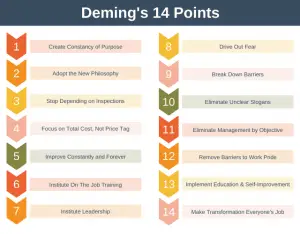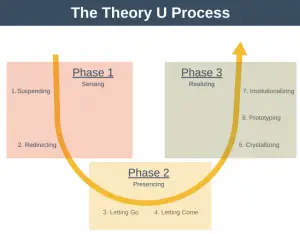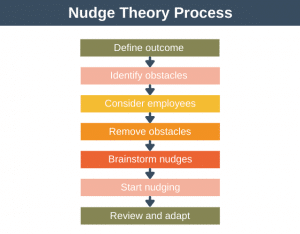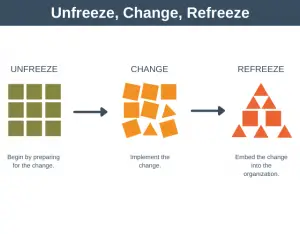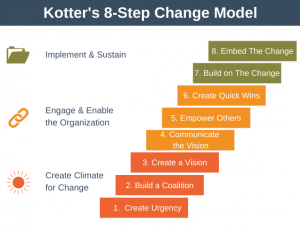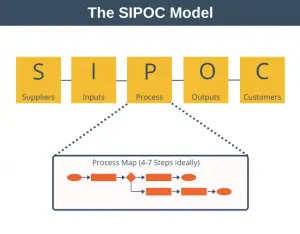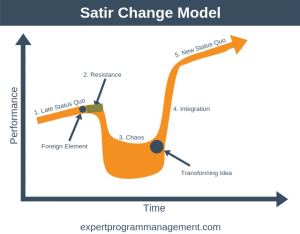To remain competitive, organizations must continuously change. Without change, organizations stagnate, become uncompetitive and irrelevant, or go out of business.
To thrive, organizations must accelerate their speed of change to execute faster than their competition. Thus, change is not just important but critical to every organization.
Because of the importance of change, all leaders must ask themselves a critical question: How can I ensure that my change is successful?
What is a Change Management Model?
Change management models are simply guides or instructions to help you successfully lead change. No two change management models are the same but broadly speaking they fall into two categories – those that focus on the process of change (the steps you must take) and those that focus on the human response to change.
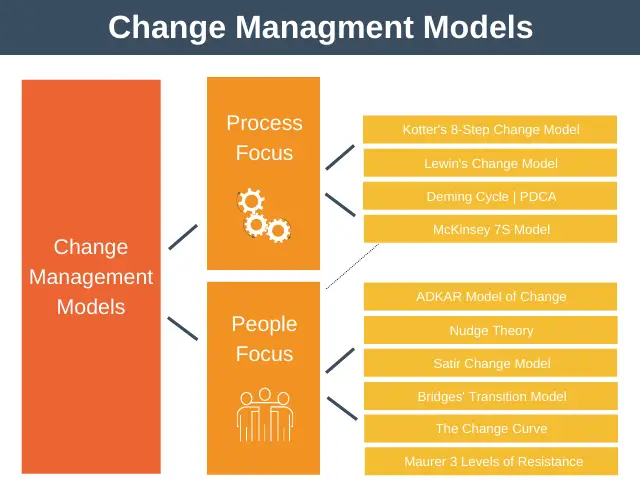
Which change management model you choose is up to you and will depend on your particular circumstances. However, it’s worth noting that you combine elements of different change models; for example, Kotter’s 8-Step Change Model can be used alongside the Change Curve.
Note that the McKinsey 7S Model is mostly process-focused but contains elements of people focus.
10 Change Management Models
There are ten change management models we’re going to consider in this article.
- Kotter’s 8-Step Change Model
- Lewin’s Change Model
- Deming Cycle | PDCA
- McKinsey 7S Model
- ADKAR Model of Change
- Nudge Theory
- Satir Change Model
- Bridges’ Transition Model
- The Change Curve
- Maurer 3 Levels of Resistance
Let’s get started and explore each model in more detail. If you’d like more detail on any of these models, then there are links below you can use to learn more.
1. Kotter’s 8-Step Change Model
John P. Kotter first described his model in a 1995 article in the Harvard Business Review.
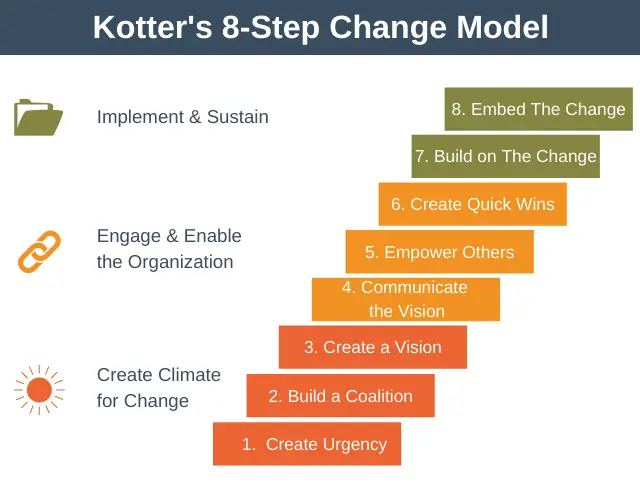
Broadly speaking, we can say there are three phases to the Kotter change model:
- Create a climate for change: this phase is about creating a shared understanding of the change you want to make and why you want to make it.
- Engage and enable the organization: this phase is about engaging your team so that they are empowered and enthusiastic about effecting change with the organization.
- Implement and sustain: this phase is about pressing ahead after your initial successes to build momentum and fully embed the change within your organization.
2. Lewin’s Change Model
Kurt Lewin is widely considered a founding pioneer of change management. It is worth noting that there is evidence that Lewin never developed the 3-Step model and that it only came into being after his death.

Lewin’s Change Model involves creating the desire to want to unfreeze the current status quo, implement the necessary changes, and then solidify the new ways of working as the new normal.
3. Deming Cycle | PDCA
The PDCA Cycle is a tool that can help you continuously improve your products, services, and organizational processes. It is a four-stage cycle for continuous improvement.
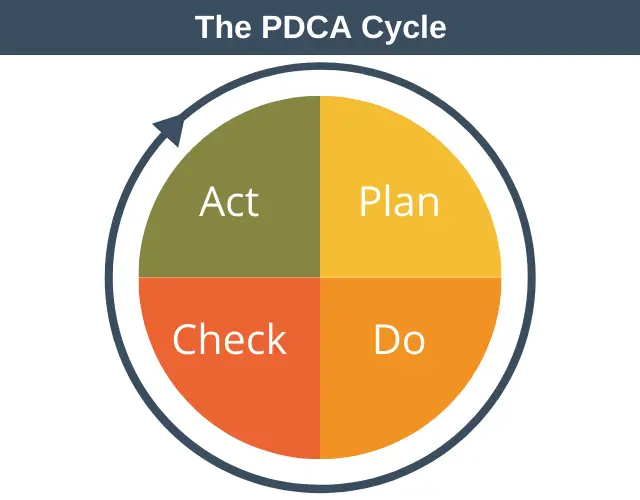 The PDCA Cycle is an excellent tool for reaching any goal or introducing improvements. You perform many cycles of the PDCA loop.
The PDCA Cycle is an excellent tool for reaching any goal or introducing improvements. You perform many cycles of the PDCA loop.
Each cycle begins with a planning stage in which you identify and understand issues. You then generate solutions and choose the best one. In the Do stage, you implement your solution in a small-scale way.
You then check the results in the Check phase to see if they are as expected. Finally, if your solution performs as hoped, you roll it out in full in the Act stage before beginning the PDCA Cycle again.
4. McKinsey 7S Model
McKinsey 7S Model is a strategic planning tool designed to help an organization understand if it is set up in a way that allows it to achieve its objectives.
Before the advent of the 7S Model, when managers thought about organizational design, they tended to focus on their organizational structure.
However, as organizations got larger and more complex, coordination became just as important, if not more important, than structure.
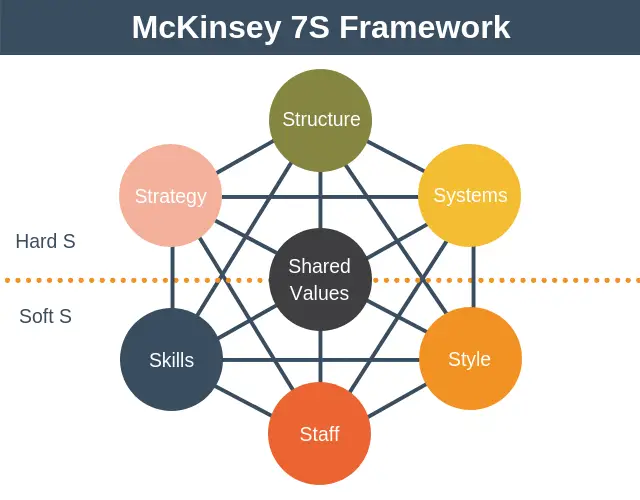
There are several things to note from this diagram:
- All the areas are interconnected. This means that a change to one area will affect all other areas.
- There is no hierarchy, and all areas are the same size. This indicates that all areas are considered to be equally important.
- The areas are divided into hard and soft areas. Hard areas are easy for management to influence and change. Soft areas are more woolly and influenced by the culture of the organization.
- Positioning Shared Values in the center of the 7Ss indicates that the organization’s values are central to all elements.
5. ADKAR Model of Change
The ADKAR Model of Change is different from many other change management models because is it focuses on guiding change at the individual level. In contrast, most change models drive change at the organizational level.
It focuses on the individual because the people within that organization must change first for an organization to change.

The ADKAR framework is an acronym made up of the five steps a person needs to undertake to be willing and able to change. You carry out the steps in order, with each step building on the previous step.
6. Nudge Theory
Nudge Theory is based on the idea that people can be nudged to make the right choice without coercing them or restricting their freedom of choice.
It works by leveraging the biases inherent in every human being to nudge people towards exhibiting the desired behavior.
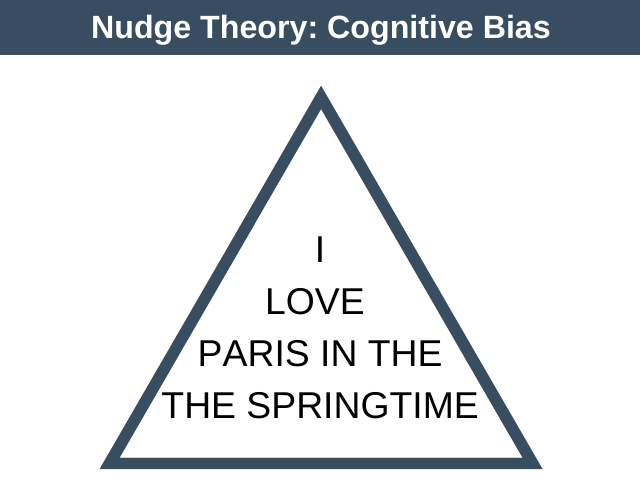
Quickly read the text contained in this image. The majority of people don’t notice the second “the” when they read this text for the first time.
If you did the same, that’s because you’re using a mental shortcut to read the text rather than using your reflective thinking brain. The purpose of this example is to show you that every one of us has cognitive biases. All Nudge Theory does is leverage these biases to move us towards taking specific action.
7. Satir Change Model
This model was designed to help people improve how they cope with major unexpected change.
Although the model was developed initially for family therapy, it also applies to how people cope with organizational change.

At the heart of the Satir Change Model is the conviction that it is always possible for things to get better. However, this takes time, and things usually get worse before they get better.
On the vertical axis, we have our team’s performance, and on the horizontal axis, we have time.
One crucial point to realize about the curve within the diagram is that it is deliberately not a thin line. This means that our team’s performance can oscillate within the bounds set by the curve. Or to put it another way, some days will be better than others for our team.
As you can see from the diagram, there are five stages of the Satir Change Model.
8. Bridges’ Transition Model
Bridges Transition Model is a three-stage model that enables you to understand and manage the human side of change more effectively.
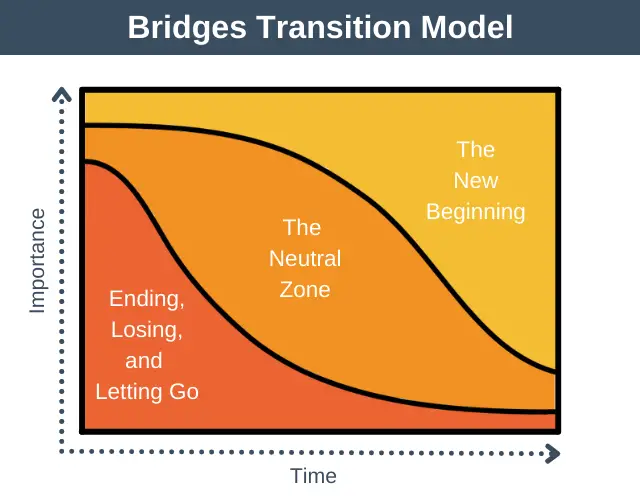
The model helps organizations manage change successfully by mapping out the human response to change over three stages. These are:
- Ending, Losing, and Letting Go: allow people to let go and say goodbye to old ways.
- The Neutral Zone: the in-between time when the old is no more, but the new hasn’t arrived yet.
- The New Beginning: the confusing time when people begin to engage in their new future.
9. The Change Curve
The Change Curve helps us understand how people emotionally experience a major disruptive change.

It provides a general rule of thumb as to how people emotionally handle change. It was first used to model how people come to terms with a terminal illness.
Knowledge of the change curve can help us as managers improve how we interact with those undergoing change, ultimately making the change achieve success more quickly and decreasing the duress on our team.
10. Maurer 3 Levels of Resistance
This model is based on the idea that people resist change to protect themselves from harm. As a leader, the better you are at seeing what causes resistance to change, the easier it will be to overcome that resistance and garner support for your initiatives.
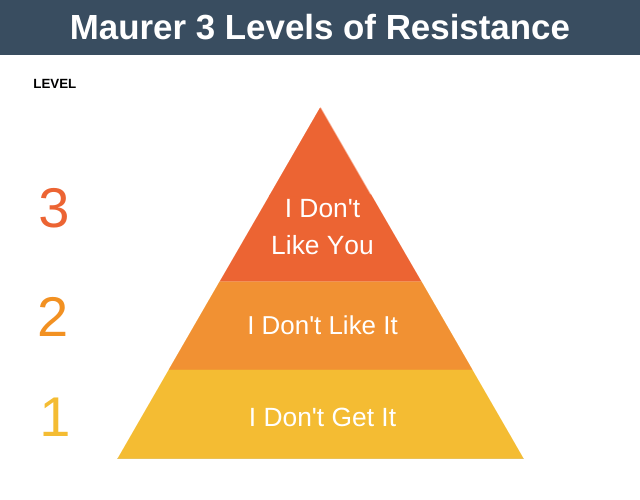
The three levels of resistance are:
- Level 1: I Don’t Get It: At this level, people are missing the facts and figures to understand why the change is necessary.
- Level 2: I Don’t Like It: At this level, people experience an emotional response to the change. It is difficult for them to take on board new ideas when they’re in fight-or-flight mode.
- Level 3: I Don’t Like You: People are not resisting the change at this level, but they don’t trust your ability to deliver it.
Summary
Like all change management models, the ten change management models we’ve looked at each provide guidelines to help you successfully lead change. Two major categories of change management models exist, one focused on the process side of change and the other on the people side. You can take the best bits from different to suit your particular situation and needs.
